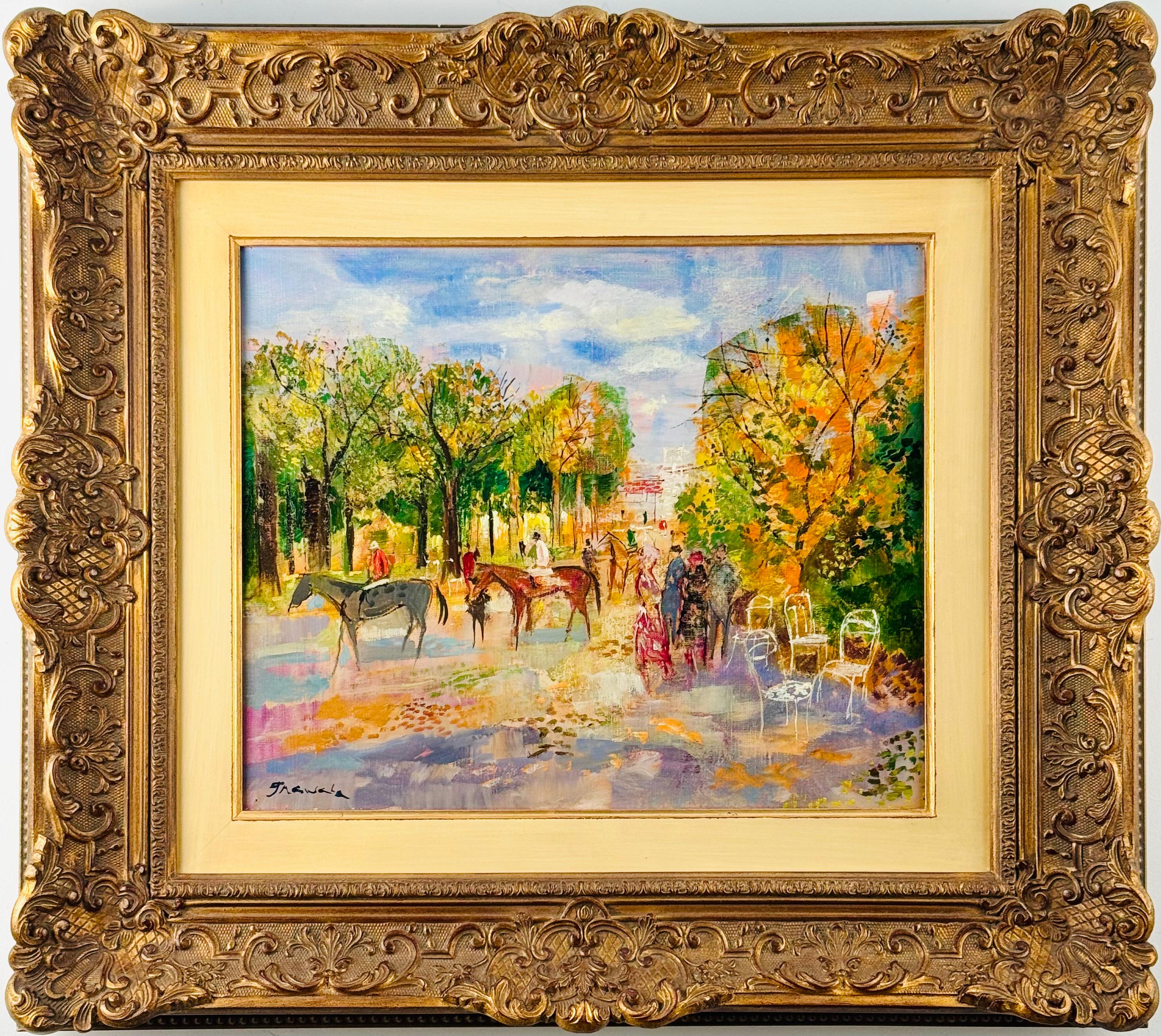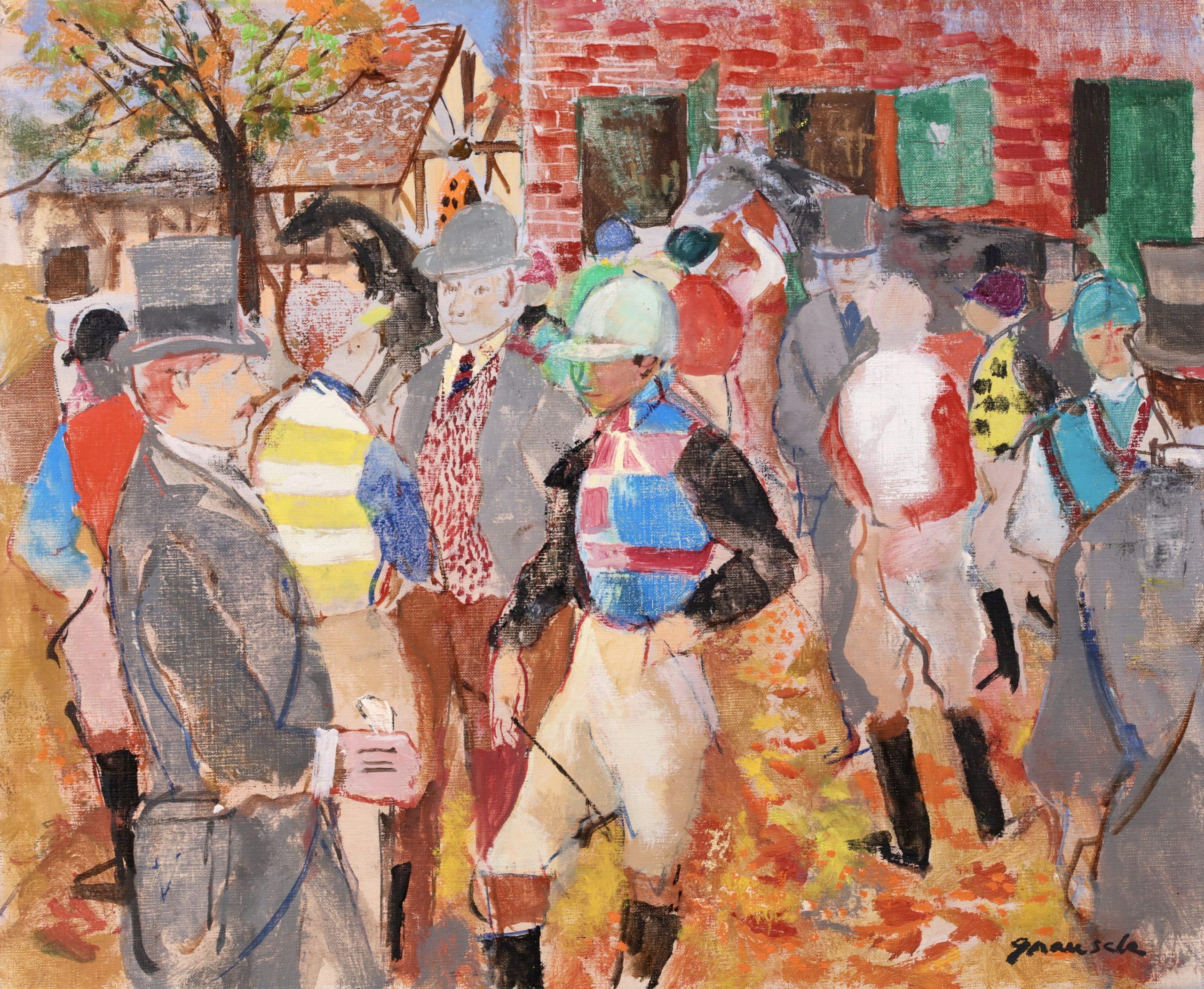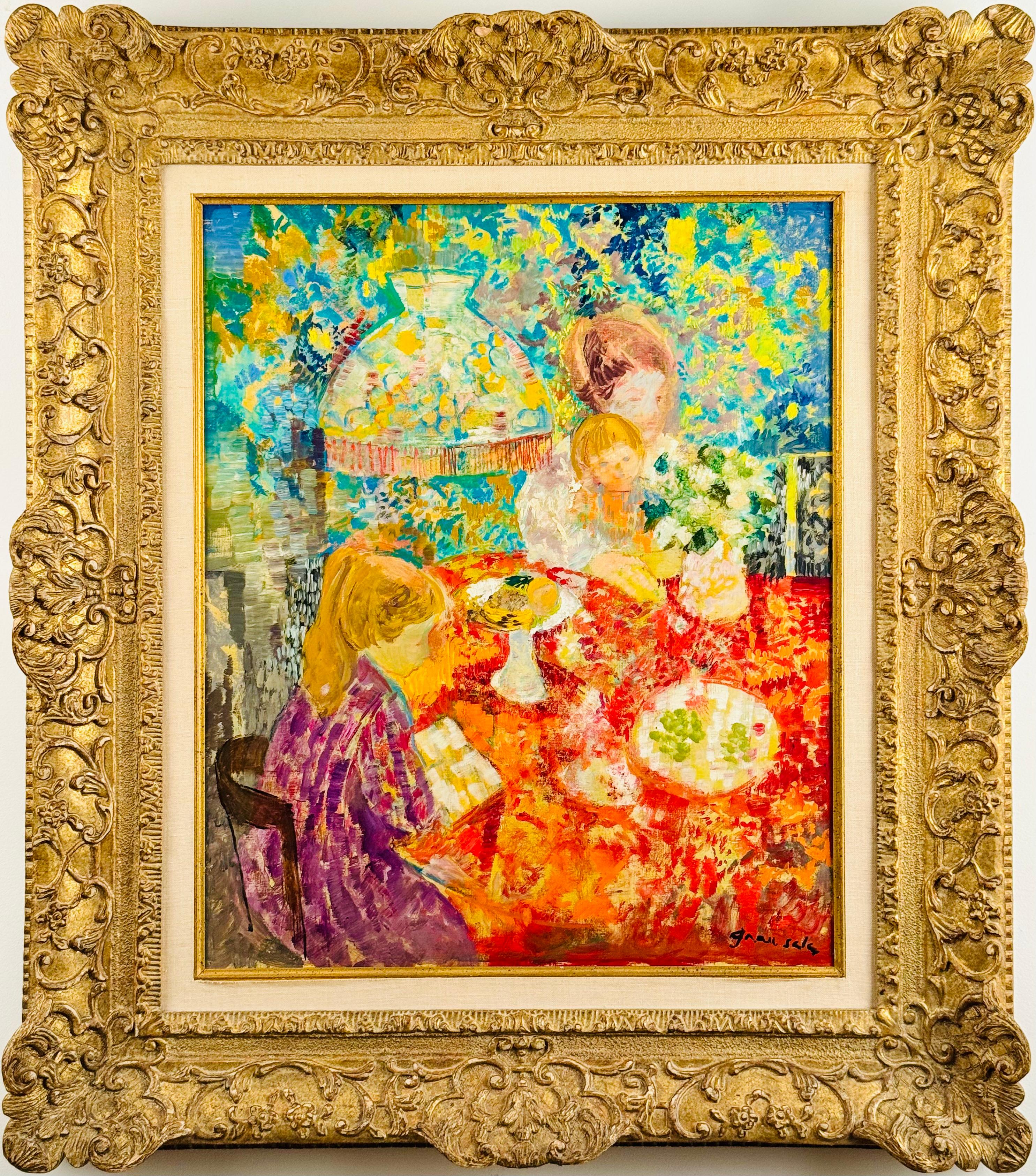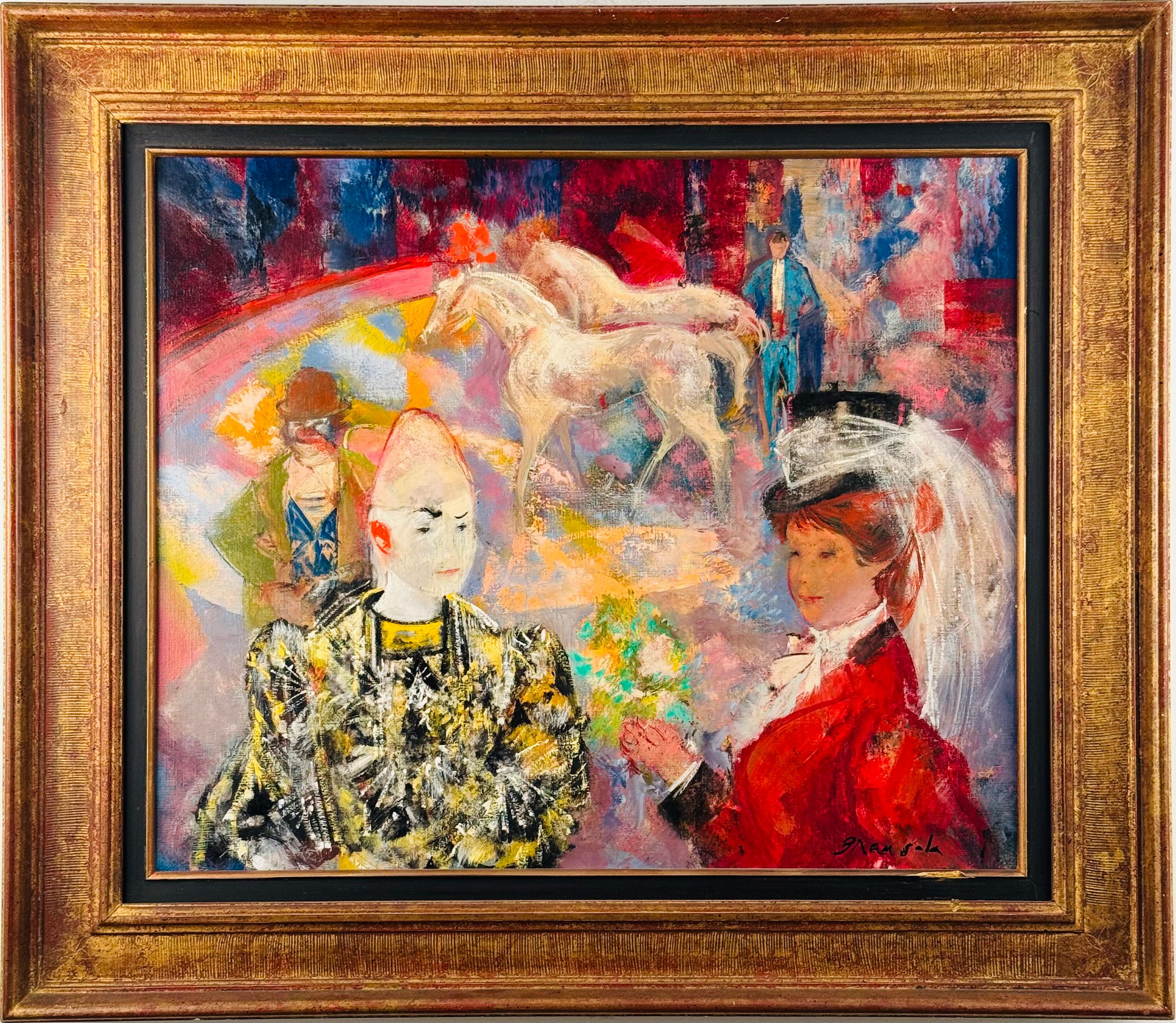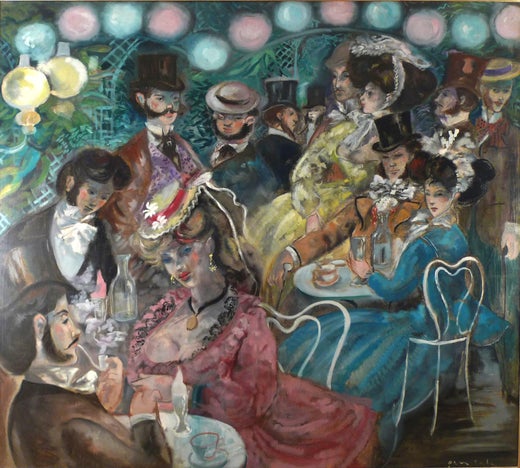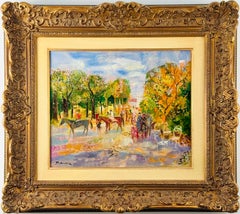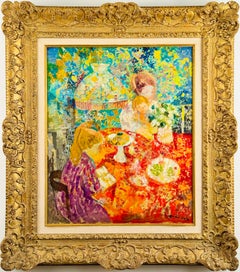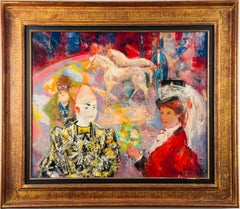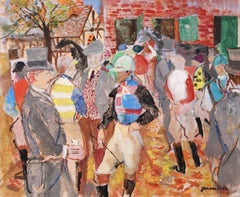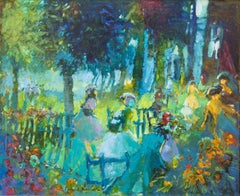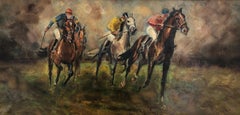Items Similar to Paddock
Want more images or videos?
Request additional images or videos from the seller
1 of 11
Emilio Grau SalaPaddockCirca 1960
Circa 1960
$17,625
£13,496.59
€15,000
CA$24,771.98
A$27,173.51
CHF 14,217.60
MX$323,418.79
NOK 179,576.93
SEK 168,446.38
DKK 114,268.95
About the Item
EMILIO GRAU SALA
Spanish, 1911 - 1975
PADDOCK
signed "Grau Sala" (lower right)
oil on canvas
21-1/3 x 25-1/2 inches (54 x 65 cm.)
framed: 27-1/2 x 32 inches (70 x 81 cm.)
PROVENANCE
Private Collection, New York
Emilio Grau Sala came from a family of artists. He was born in Barcelona in 1911 and his father, a good cartoonist, had been one of the promoters of the "Salon des Humanistes" and made his exhibitions normally in "Sala Parés", Barcelona.
His first works were exhibited at the Salon des Independents. In the years 1930-33 he had painted under the influence of Cubism, especially that of Torres García. It is from that time a painting of the port of Barcelona, geometric and structural, which completely anticipated what would later be his work. His personality began fully painting watercolors and oils with a certain fantasy character, with a point of decorative instinct and themes full of naivety and grace. Romantic interiors, paddocks, port scenes, sailors, etc.
Grau Sala was essentially a Mediterranean painter, son of post-impressionism and enriched with French painting of the last fifty years. Mediterranean because his work has the color and light of that land.
He understood and assimilated impressionist painting very well, and for that reason he was never subject to the modules of a formulist realism, nor the sexigencias of the forms.
In Paris he found the best environment to give us a fruitful and intense work, because he could use the expressive potential of French art to enrich it.
All this made him a very esteemed artist everywhere where his work was known. He was also very often required to illustrate books and publications in Paris. Also his posters were very successful.
He painted a large number of subjects, but perhaps the theme of horse racing is where you can see in a very clear way the joyful and optimistic life that was lived at that time. In this fabric there is an explosion of juicy and vivid colors full of ingenuity and simplicity in its composition. Only a teacher could turn the complicated into something simple and beautiful. Before this work we feel a deep emotion, the emotion of before starting a horse race. Joy and nervousness at the same time. Especially since it is a direct emotion. There are no intermediaries between our eyes and what the work intends to tell us. This is precisely what seduces and catches us of this painting.
His works can be found in the Museums of the Villa de Paris, L'Ile de France Museum, at the Château de Sceaux, Honfleur Museum, La Rochelle Museum, Barcelona Museum, Tossa de Mar Museum, Philadelphia Museum, Museum of Buenos Aires, etc.
EXHIBITION
Museo de Arte Moderno, Madrid
Galería Muller, Buenos Aires
Dindley Gallery, New York
Outdoor and Autumn Halls, Paris
Galería Charpentier, París
Monique de Groote, París
Sala Parés, Barcelona
Sala Rovira, Barcelona
Sala Syra, Barcelona
- Creator:Emilio Grau Sala (1911-1975, Spanish)
- Creation Year:Circa 1960
- Dimensions:Height: 21.26 in (54 cm)Width: 25.6 in (65 cm)
- More Editions & Sizes:54 x 65 cm.Price: $17,625
- Medium:
- Movement & Style:
- Period:
- Condition:
- Gallery Location:Madrid, ES
- Reference Number:1stDibs: LU1281114184162
Emilio Grau Sala
Emilio Grau Sala came from a family of artists. He was born in Barcelona in 1911 and his father, a good cartoonist, had been one of the promoters of the "Salon des Humanistes" and made his exhibitions normally in "Sala Parés", Barcelona. His first works were exhibited at the Salon des Independents. In the years 1930-33 he had painted under the influence of Cubism, especially that of Torres García. It is from that time a painting of the port of Barcelona, geometric and structural, which completely anticipated what would later be his work. His personality began fully painting watercolors and oils with a certain fantasy character, with a point of decorative instinct and themes full of naivety and grace. Romantic interiors, paddocks, port scenes, sailors, etc. Grau Sala was essentially a Mediterranean painter, son of post-impressionism and enriched with French painting of the last fifty years. Mediterranean because his work has the color and light of that land.
He understood and assimilated impressionist painting very well, and for that reason he was never subject to the modules of a formulist realism, nor the sexigencias of the forms. In Paris he found the best environment to give us a fruitful and intense work, because he could use the expressive potential of French art to enrich it.
All this made him a very esteemed artist everywhere where his work was known. He was also very often required to illustrate books and publications in Paris. Also his posters were very successful. He painted a large number of subjects, but perhaps the theme of horse racing is where you can see in a very clear way the joyful and optimistic life that was lived at that time. In this fabric there is an explosion of juicy and vivid colors full of ingenuity and simplicity in its composition. Only a teacher could turn the complicated into something simple and beautiful. Before this work we feel a deep emotion, the emotion of before starting a horse race. Joy and nervousness at the same time. Especially since it is a direct emotion. There are no intermediaries between our eyes and what the work intends to tell us. This is precisely what seduces and catches us of this painting. His works can be found in the Museums of the Villa de Paris, L'Ile de France Museum, at the Château de Sceaux, Honfleur Museum, La Rochelle Museum, Barcelona Museum, Tossa de Mar Museum, Philadelphia Museum, Museum of Buenos Aires, etc. EXHIBITION
Museo de Arte Moderno, Madrid
Galería Muller, Buenos Aires
Dindley Gallery, New York
Outdoor and Autumn Halls, Paris
Galería Charpentier, París
Monique de Groote, París
Sala Parés, Barcelona
Sala Rovira, Barcelona
Sala Syra, Barcelona
About the Seller
5.0
Vetted Professional Seller
Every seller passes strict standards for authenticity and reliability
Established in 1977
1stDibs seller since 2019
21 sales on 1stDibs
Typical response time: 2 hours
- ShippingRetrieving quote...Shipping from: Madrid, Spain
- Return Policy
More From This Seller
View AllPaddock, 1970
By Emilio Grau Sala
Located in Madrid, ES
EMILIO GRAU SALA
Spanish, 1911 - 1975
PADDOCK, 1970
signed "Grau Sala" (lower left)
signed, dated and titled "GRAU SALA / 1970 / "Paddock"" (on the reverse)
oil on canvas
15 x 18-1/8...
Category
1970s Post-Impressionist Figurative Paintings
Materials
Canvas, Oil
“Paddock, 1961”, 20th Century Oil on Canvas by Spanish Artist Emilio Grau Sala
By Emilio Grau Sala
Located in Madrid, ES
EMILIO GRAU SALA
Spanish, 1911 - 1975
PADDOCK, 1961
signed "Grau Sala" (lower right)
signed again, titled & dated "GRAU SALA / PADDOK / 1961" (on the reverse)
oil on canvas
21-3/8 x ...
Category
1960s Post-Impressionist Figurative Paintings
Materials
Canvas, Oil
SCÈNE FAMILLIALLE
By Emilio Grau Sala
Located in Madrid, ES
EMILIO GRAU SALA
Spanish, 1911 - 1975
SCÈNE FAMILLIALLE
signed "Grau Sala" (lower right)
signed, titled, located and dated "GRAU SALA / SCÈNE FALLIALLE / PARIS 1969" (on the reverse)...
Category
1960s Post-Impressionist Figurative Paintings
Materials
Canvas, Oil
Gens du cirque
By Emilio Grau Sala
Located in Madrid, ES
EMILIO GRAU SALA
Spanish, 1911 - 1975
GENS DU CIRQUE
signed "Grau Sala" (lower right)
signed, titled, located and dated "Grau Sala / Gens du cirque / París 72" (on the reverse)
oil o...
Category
1970s Post-Impressionist Figurative Paintings
Materials
Canvas, Oil
"Espagnoles, 1971", 20th Century Oil on Canvas by Artist Emilio Grau Sala
By Emilio Grau Sala
Located in Madrid, ES
EMILIO GRAU SALA
Spanish, 1911 - 1975
ESPAGNOLES, 1971
signed "Grau Sala" (lower left)
signed again, dated and titled "Grau Sala, 1971, espagnoles" (on the reverse)
oil on canvas
1...
Category
1970s Post-Impressionist Figurative Paintings
Materials
Canvas, Oil
Rond-Point des Champs-Élysées
By Emilio Grau Sala
Located in Madrid, ES
EMILIO GRAU SALA
Spanish, 1911 - 1975
ROND-POINT DES CHAMPS-ÉLYSÉES
signed "Grau Sala" (lower left)
signed, located and dated "GRAU SALA / PARIS 1967" (on the reverse)
oil on canvas
...
Category
1960s Post-Impressionist Figurative Paintings
Materials
Canvas, Oil
You May Also Like
Les Jockey & La Propietaire - Post Impressionist Figurative Oil by E Grau Sala
By Emilio Grau Sala
Located in Marlow, Buckinghamshire
Signed, titled and dated figures in landscape oil on canvas by Spanish post impressionist painter Emilio Grau Sala. The work depicts a large group of jockeys and horse owners talking...
Category
1970s Post-Impressionist Figurative Paintings
Materials
Canvas, Oil
"Soil Au Petit"
By Gerard Valtier
Located in Austin, TX
By Gérard Valtier
Medium: Oil on canvas
Size: 21" x 25"
Framed
This painting by Gérard Valtier (1950), titled "Soil au Peptit," depicts an elegant outdoor gathering scene, bathed in...
Category
Late 20th Century Post-War Figurative Paintings
Materials
Canvas, Oil
Polo game
Located in Genève, GE
Work on canvas
White Wooden frame
50 x 85 x 2 cm
Category
Late 20th Century Figurative Paintings
Materials
Oil
$1,151
In Valdumentina, Impressionist Oil Painting by Ugo Setti
By Ugo Setti
Located in Long Island City, NY
Artist: Ugo Setti, Italian (1915 - )
Title: In Valdumentina
Year: circa 1960
Medium: Oil on Canvas, signed l.l.
Size: 23.5 x 31.5 inches
Frame Size: 32 x 40 inches
Category
1960s Impressionist Animal Paintings
Materials
Canvas, Oil
Pasture, Painting, Oil on Wood Panel
By Richard Szkutnik
Located in Yardley, PA
original oil on panel paint in contemporary impressionism style :: Painting :: Impressionist :: This piece comes with an official certificate of authenticity signed by the artist :: ...
Category
2010s Impressionist Paintings
Materials
Oil
The Farm
By François Gall
Located in Wiscasett, ME
Oil on canvas, signed in the lower right.
Measures 17" x 18.5" including the frame and 8" x 10.5" sight.
Francois Gall 1912-1987 French
Well listed artist in the Benezit. He was t...
Category
Mid-20th Century Post-Impressionist Landscape Paintings
Materials
Oil
$4,900
More Ways To Browse
Tossa De Mar
Marvel Signed Art
Oil Painting Opera
Painting Of Israel
Persian Oil Painting
Ramon Oil Paintings Ramon
Red Devil
Red Nose
18th Century Venetian Paintings
Ascoli Piceno
Blue Boy Painting
Damaged Art
H R Giger
Ice Hockey Art
Impressionist Ballerina Painting
Italian Painters 20th Century
Midwest Painting
Naive Art France
